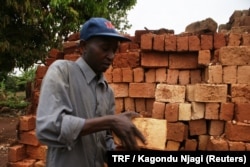Perched on a dirt tower on the edge of a bog in Kivoo village, eastern Kenya, Erastus Njiru applies finishing layers of mud to a pile of bricks.
"I can sell up to 3,000 of these per week," said the 34-year-old, inspecting his work as he dried his muddy hands with a worn towel.
"Each brick goes for 8 Kenyan shillings ($0.08), so in a good week I can make up to 24,000 Kenyan shillings ($240.00)," he told the Thomson Reuters Foundation.
Njiru is one of an increasing number of Kenyans selling and buying earth bricks to build homes which are cooler, cheaper and more environmentally friendly than the more typical stone houses.
About 15 percent of new homes are now built with mud bricks, compared to less than 1 percent in 2010, according to Aidah Munano, a senior official at the Kenyan ministry of land, housing and urban development.
Unlike quarrying, which involves clearing trees to make room for excavations, mud bricks only require a bit of dirt and water, said Gitonga Murungi, a Kenyan conservationist.
"Demand for mud bricks is on the rise in rural Kenya because they cool homes during hot days and keep them warm at night," he said.
They also cost about half as much as bricks made from stone quarrying, he added.
Njiru agrees. "People are giving up on building homes with quarry stones because they are expensive," he said.
"And the government says that quarrying and sand harvesting damage the environment," he added.
Having dropped out of high school due to a lack of funds, the former farmer now proudly pays for his children's education.
"I used to barely get by when growing maize and beans," he explained. "But now I make a lot more by selling mud bricks to residents and property developers in the area."
Rising Heat
Extreme heat across the country is a threat to many Kenyans as "their crops and livestock waste away due to a lack of water," according to Ayub Shaka, deputy director at the Meteorological Department.
Rising temperatures made Milka Njeri, a sorghum farmer from nearby Kanyuambora village consider brick-making as a way of making extra money.
Njeri said some days are so hot she has to stay indoors and can only start work in her fields as the sun sets.
Like Njiru she has started molding bricks at home using mud from a nearby bog to compensate for the lost income from farming — while sheltering from the heat.
"It is not much but I can make an extra 2,000 Kenyan shillings ($20) a week by selling bricks at construction sites," she said.
Protecting the Environment
Brick makers should ensure their work does not end up damaging the environment as well, said Violet Matiru, a conservationist at the Millennium Community Development Initiatives, a local charity that raises awareness of environmental issues.
"We need to be careful that brick-making doesn't use up all the soil in bogs because it stores excess water during floods and helps limit their impact," she explained.
James Nyang'aya, a researcher at the University of Nairobi, thinks that while mud-brick homes can help communities adapt to rising heat, they are not the only solution.
"People should not just change their homes, but (also) their way of life," he said.
Wearing light clothes and planting trees around homes to provide shade can also help cope with extreme temperatures, he said.
"You can even build your home's doors and windows according to the wind direction to create your own air conditioning," he added.
($1 = 100.0000 Kenyan shillings)







